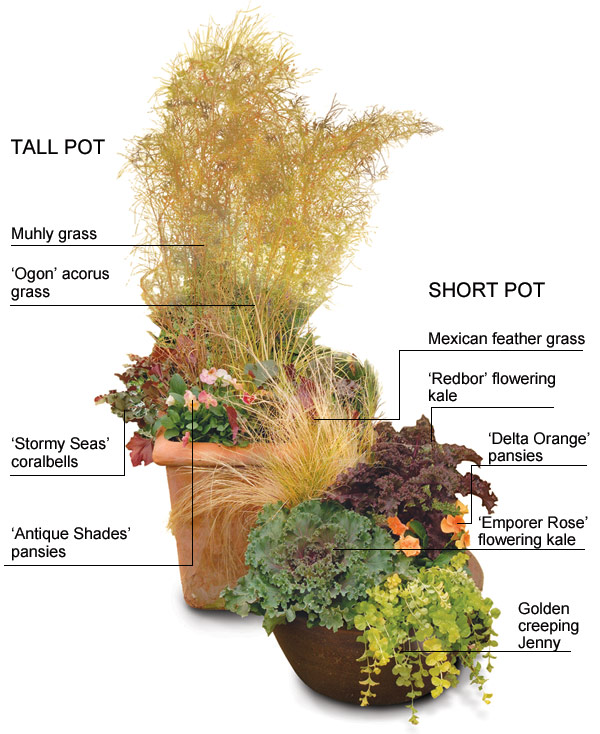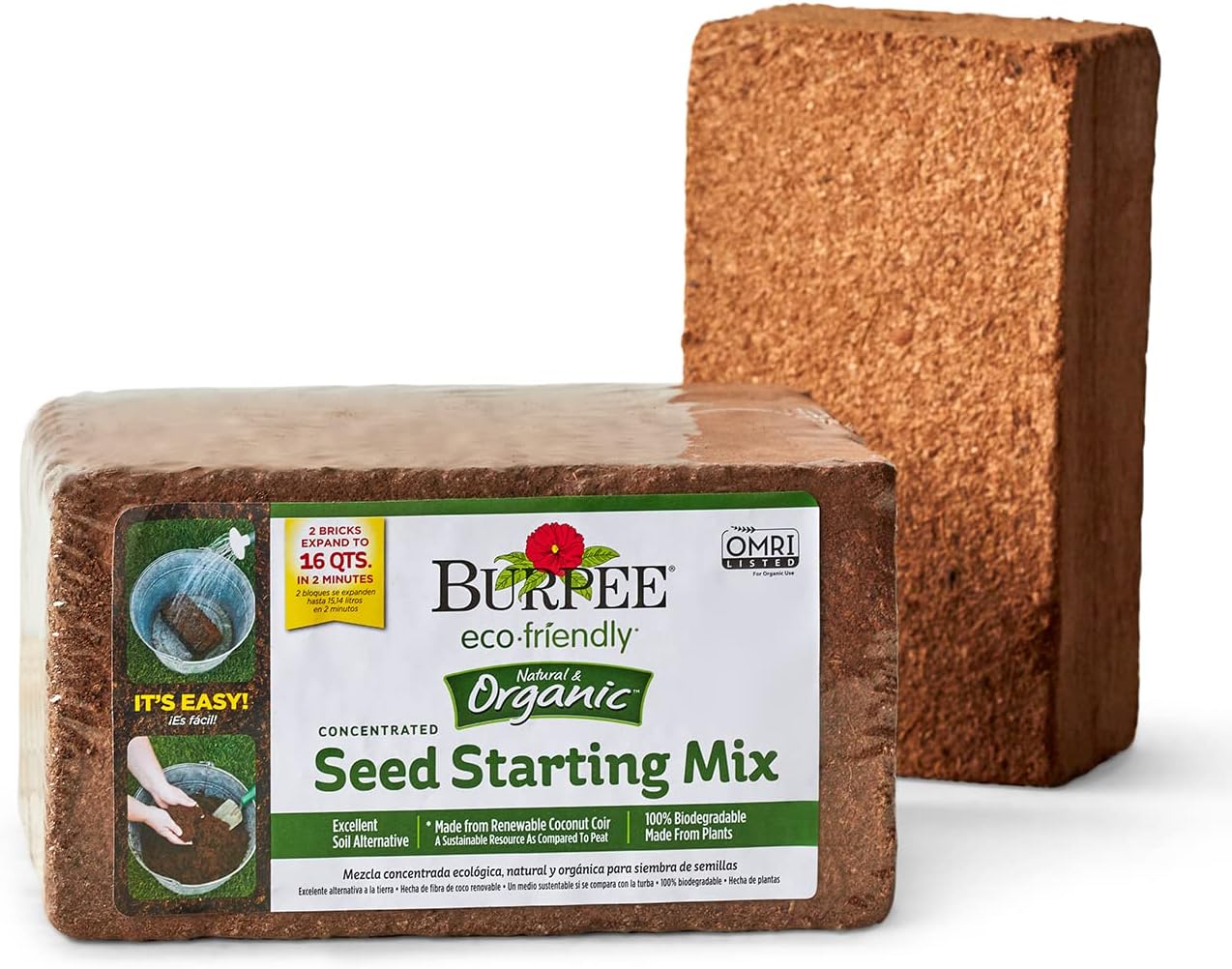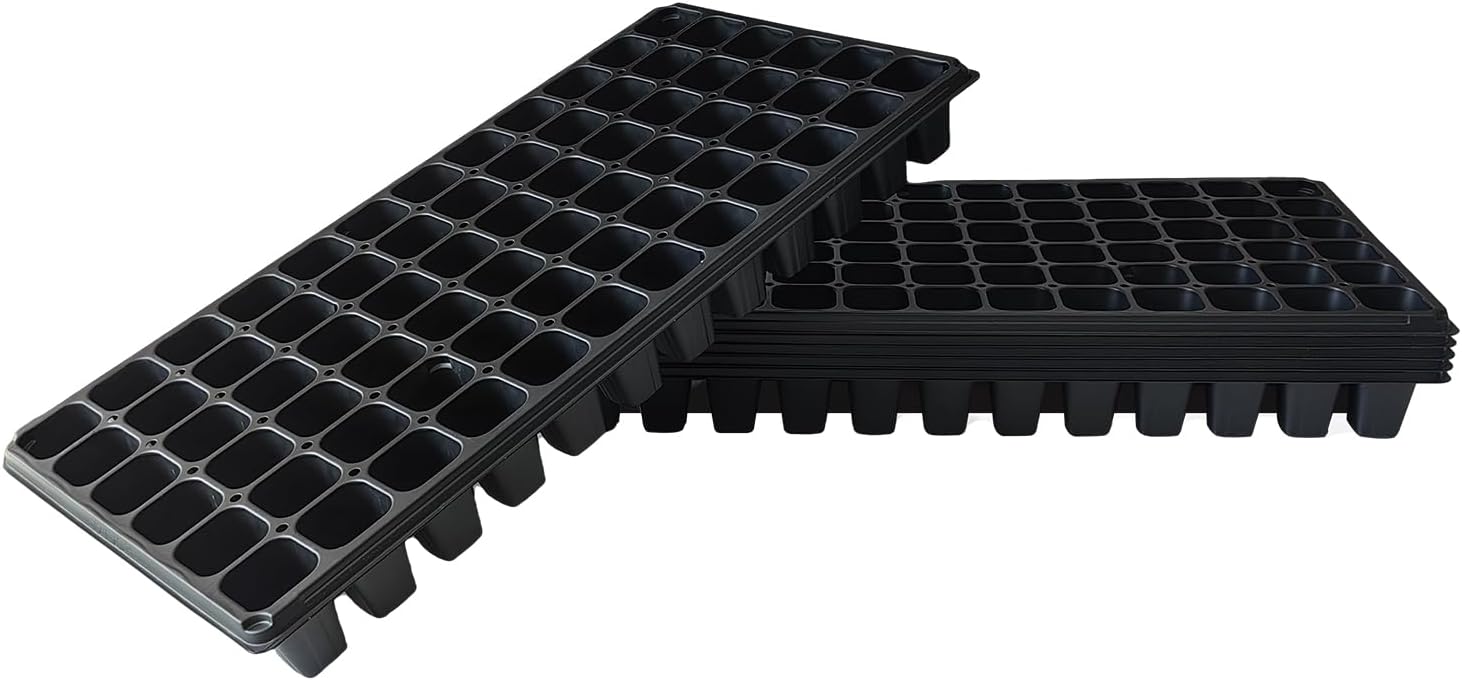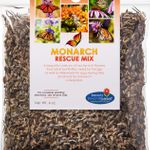Containers That Keep Kicking Into Fall
Pick plants that stand up to frost

The transition from the exuberance of summer, when my containers are looking their fullest and most luxuriant, to the first frost, when the more tender plants collapse, used to be an upsetting time for me. But over the last few years, I’ve learned that the onset of autumn doesn’t have to mean the end of the container gardening season.
A trip to the garden center in September or October seems, at first glance, to yield the same old choices of mums and pansies. Although I still rely on pansies, grasses, kale, and garden mums to dress up my containers, I also use many other plants that look good into fall.
Another less expensive and more readily available source for plant material is my own garden. Taking a division from a clump of coral bells (Heuchera spp. and cvs.), a sedge (Carex spp. and cvs.), an ornamental grass, or a sedum (Sedum spp. and cvs.) and potting it up in summer for use in my fall containers saves quite a bit of money. Occasionally, I’ll even use a plant that was part of a summer container that can withstand a frost or two, like English ivy (Hedera helix cvs.) or golden creeping Jenny (Lysimachia nummularia ‘Aurea’). Other decorative materials, like cornstalks, branches, and even gourds or pumpkins can be used to round out the picture.
Use small pots to accent large combination planters
I use so many types of plants in so many pots that I’ve had to come up with a design strategy that works. My biggest concern is providing continuity to the design, and I do this typically by potting up a few large combination planters with an assortment of plants. Then I repeat the colors and textures I’ve used in the mixed planters in smaller pots with single plants and position the pots in pleasing arrangements. In general, I use crisp autumnal shades to reflect the colors of the surrounding landscape.
In last year’s garden the dominant colors were purple, burgundy, orange, and yellow. The velvety purple of the flower spikes of the late-blooming Mexican bush sage (Salvia leucantha) was carried through the design with three types of purple-leaved ornamental kale and the garden mum ‘Valerie’ (Chrysanthemum ‘Valerie’). Bronze and burgundy were represented by a tall growing mahogany- colored flax (Phormium tenax ‘Atropurpureum’), pansies (Viola × wittrockiana ‘Antique Shades’), various garden mums, coral bells, leatherleaf sedge (Carex buchananii), purple wood spurge (Euphorbia amygdaloides ‘Purpurea’), and the bronzed foliage of the firecracker plant (Cuphea ignea ‘David Verity’).
To represent the brighter colors of fall, I incorporated the bright-orange tubular blooms of the firecracker plant, more mums and pansies, and a salmon-colored osteospermum (Osteospermum ‘Orange Symphony’). Two other osteospermums (O. ‘Lemon Symphony’ and O. ‘Cream Symphony’) mimic the yellow leaf color of the surrounding trees and are both great fall performers, able to withstand a few frosts. More yellow and gold flower color comes from pansies (Viola × wittrockiana ‘Delta Fire’, ‘Bingo Yellow Blotch’, and ‘Crystal Bowl Yellow’), mums, late-season dahlias (Dahlia spp. and cvs.), and the sunny yellow marguerite daisy (Argyranthemum frutescens ‘Butterfly’). The foliage of golden creeping Jenny (Lysimachia nummularia ‘Aurea’) and a chartreuse-variegated acorus grass (Acorus gramineus ‘Ogon’) round out the warm fall colors.
Once I get the containers in place, I water them using a balanced, water-soluble fertilizer. Because the weather is cooler, the pots don’t need to be watered as often as summer pots do, so I get to spend more time sitting back and enjoying the bounty that fall has to offer. And come December, if the snow and ice hold off long enough, the ornamental kale, dried grasses, and seed heads of some of the perennials from my fall containers might even make it into a few of my winter displays.
Assemble a colorful autumn display
Limiting the color palette in this case to mostly purple, burgundy, orange, and yellow helps create cohesion in this large group of containers.
Plant key
- Phormium tenax ‘Atropurpureum’
- Salvia leucantha
- Chrysanthemum ‘Luciane’
- Chrysanthemum ‘Valerie’
- Lysimachia nummularia ‘Aurea’
- Bergenia ‘Autumn Glory’
- Viola × wittrockiana cvs.
- Euphorbia amygdaloides ‘Purpurea’
- Brassica oleracea ‘Redbor’
- Heuchera ‘Stormy Seas’
- Muhlenbergia dumosa
- Dahlia ‘Powder Puff Mix’
Combinations that work


A fall container garden doesn’t have to be elaborate to be attractive. I created a container combination using two terra-cotta pots: a tall square pot with an 18-inch opening and a shorter, round container. I placed them along the edge of a path just off my patio, which helps draw visitors into the garden. For the taller pot, I chose muhly grass (Muhlenbergia dumosa) as my central plant, then added an acorus grass (Acorus gramineus ‘Ogon’), whose bright gold-and-green-striped foliage contrasts nicely with the feathery muhly grass. I added two maroon-leaved coral bells (Heuchera ‘Stormy Seas’) and similarly shaded pansies (Viola × wittrockiana ‘Antique Shades’), which work nicely with the coral bells’ foliage.
For the complementary container, I didn’t need another plant for height, but I did want to mimic the grass, so I chose the low-growing Mexican feather grass (Stipa tenuissima). The wispy, blond, hairlike foliage of the Mexican feather grass softens the face of the pot behind it and, in addition, provides a good backdrop for the large, coarse, deep red leaves of flowering kale (Brassica oleracea ‘Redbor’). These two plants make a vibrant combination when placed with a more traditional ornamental kale (B. oleracea ‘Emperor Rose’), golden creeping Jenny (Lysimachia nummularia ‘Aurea’), and the glowing orange blooms of pansy (V. × wittrockiana ‘Delta Orange’).
Fall container choices
Plants for foliage or flowers
- African daisies (Osteospermum spp. and cvs., Zones 10–11)
- Asters (Aster spp. and cvs., Zones 4–8)
- Chard (Beta vulgaris subsp. cicla and cvs., annual)
- Chrysanthemums (Chrysanthemum spp. and cvs., Zones 8–10)
- Coral bells (Heuchera ‘Stormy Seas’, Zones 3–8)
- Flowering maples (Abutilon spp. and cvs., Zones 8–10)
- Hebes (Hebe spp. and cvs., Zones 8–11)
- Lavender cottons (Santolina chamaecyparissus and cvs., Zones 6–9)
- Marguerite daisies (Argyranthemum spp. and cvs., Zones 10–11)
- Nemesias (Nemesia cvs., annual)
- Ornamental cabbages and kales (Brassica oleracea cvs., annual)
- Pansies (Viola × wittrockiana cvs., Zones 4–8)
- Pigsqueaks (Bergenia spp. and cvs., Zones 3–8)
- Shrubby haloragis (Haloragis erecta cvs., Zones 6–10)
- Snapdragons (Antirrhinum majus cvs., annual)
- Spurges (Euphorbia spp. and cvs., Zones 4–10)
- Stonecrops (Sedum spp. and cvs., Zones 3–9)
Plants for height
|
Plants that trail
|
Dennis Schrader is co-owner of Landcraft Environments Ltd., a wholesale nursery in Mattituck, New York.
Photos, except where noted: Dennis Schrader
Fine Gardening Recommended Products

Burpee Organic Coconut Coir Concentrated Seed Starting Mix, 16 Quart
Fine Gardening receives a commission for items purchased through links on this site, including Amazon Associates and other affiliate advertising programs.

Deep 72 Cell Seedling Trays (10-Pack)
Fine Gardening receives a commission for items purchased through links on this site, including Amazon Associates and other affiliate advertising programs.

Monarch Butterfly Rescue Wildflower Seeds 4 oz.
Fine Gardening receives a commission for items purchased through links on this site, including Amazon Associates and other affiliate advertising programs.









Comments
Beautiful pots! Thanks for the great ideas and all the plant names.
Log in or create an account to post a comment.
Sign up Log in